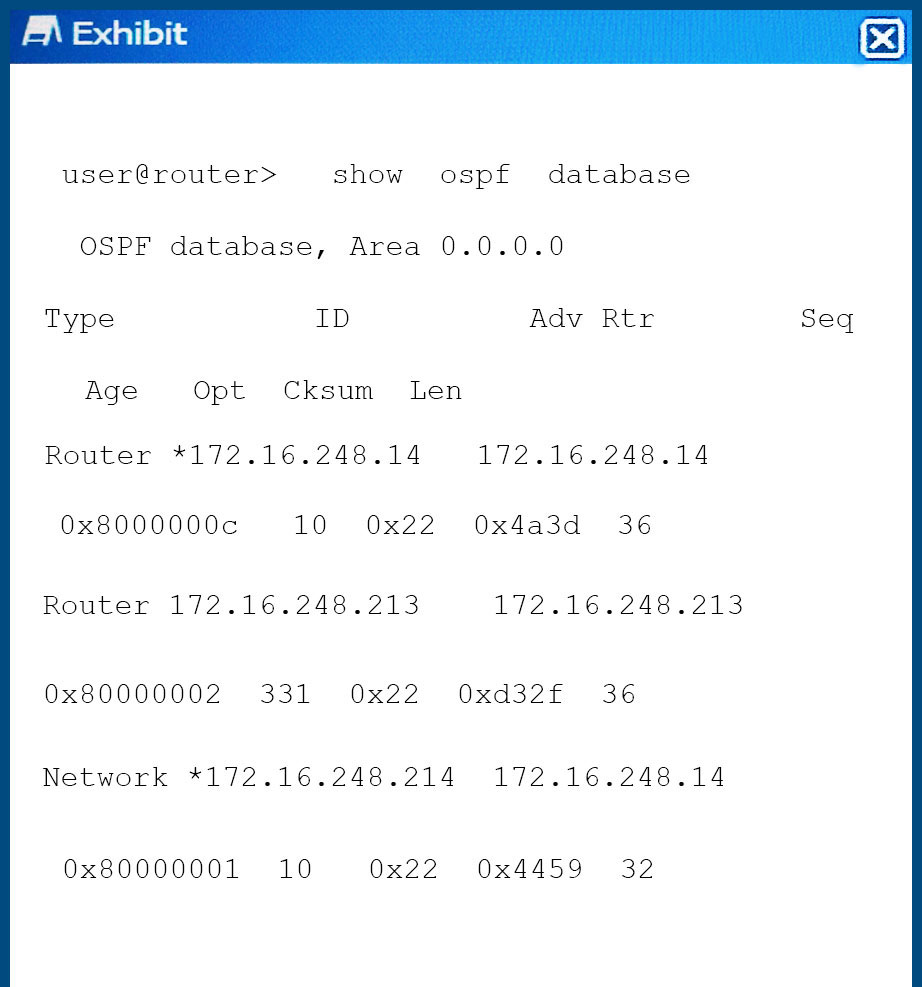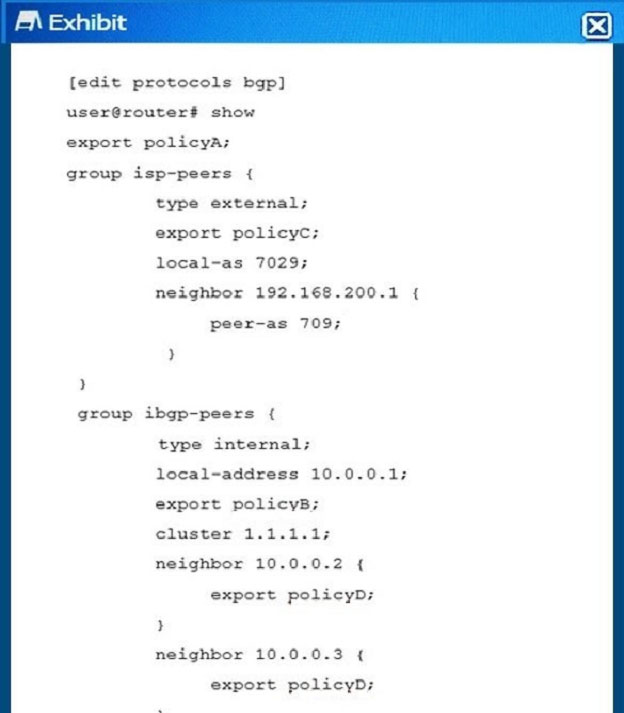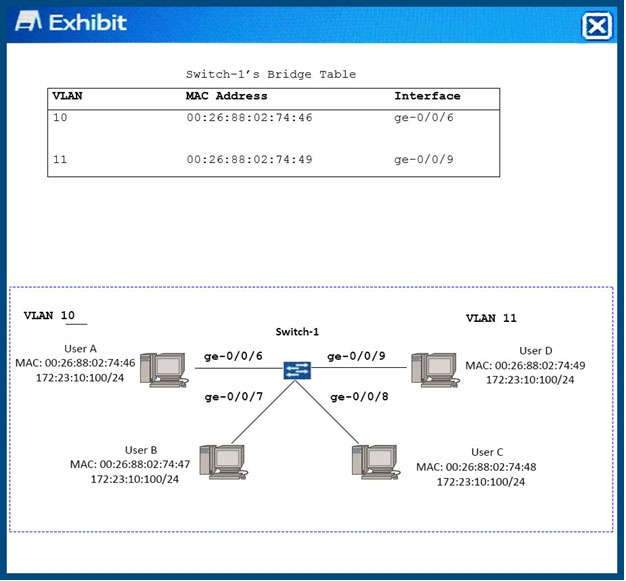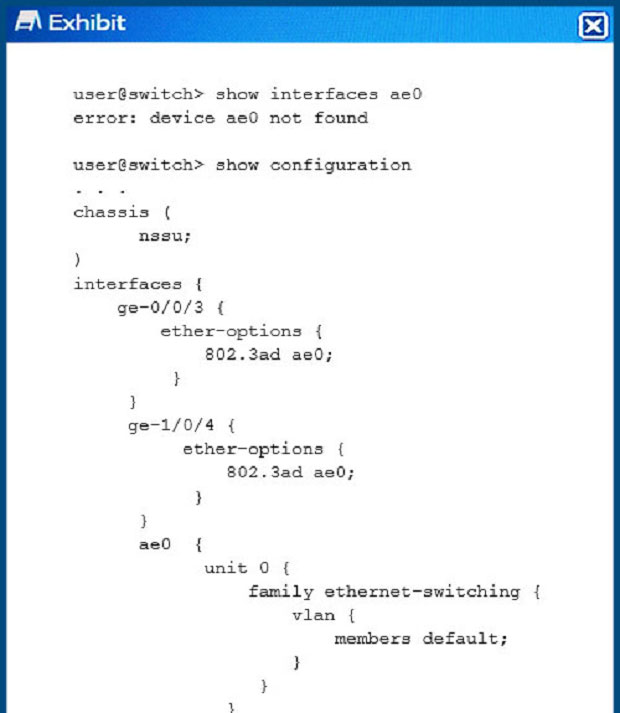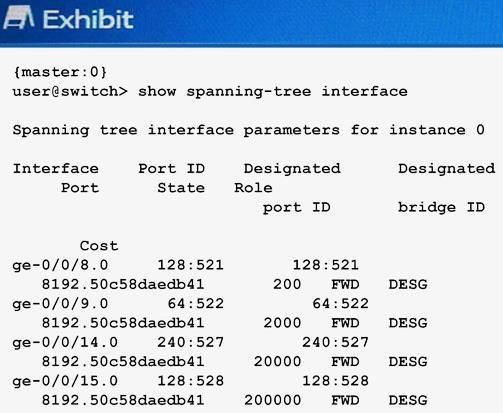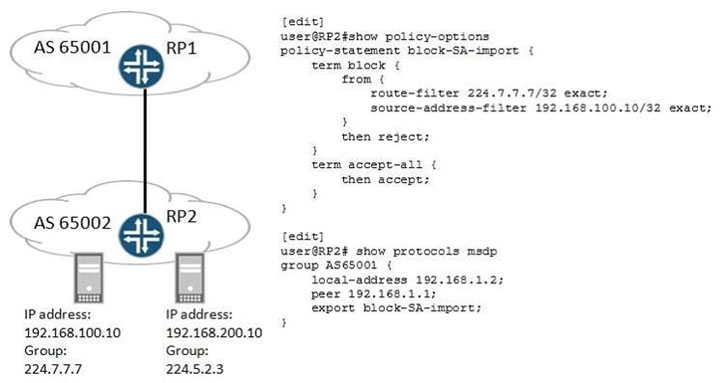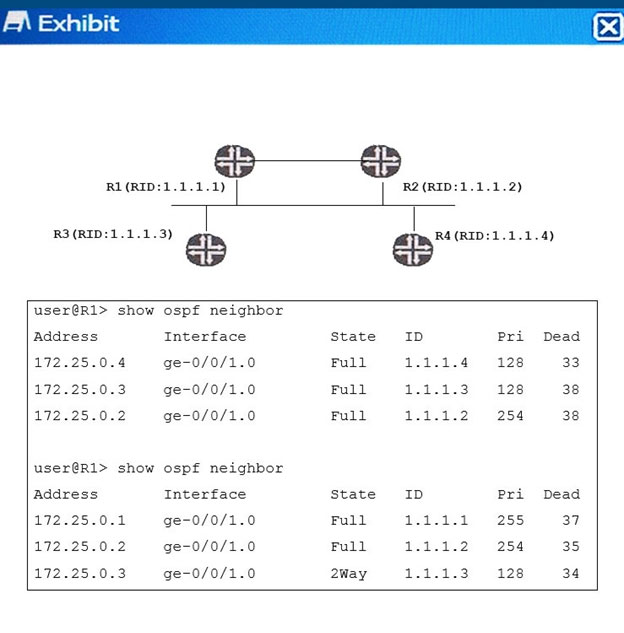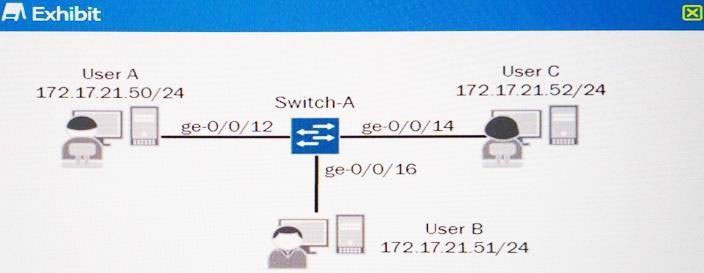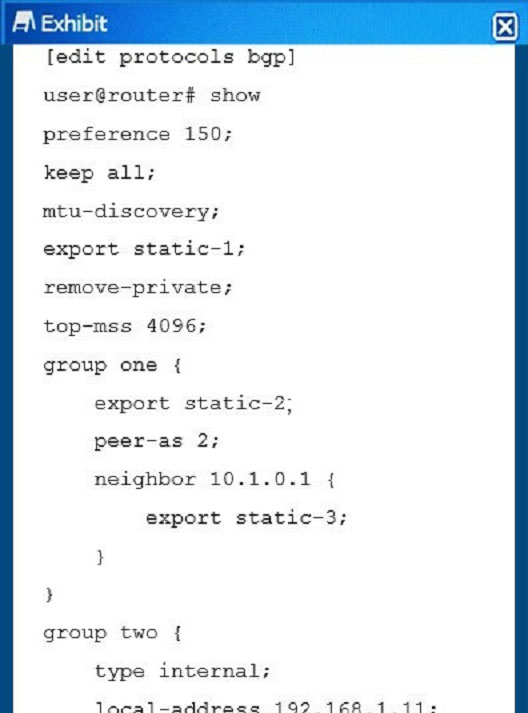JN0-347 Mock Test Free – 50 Realistic Questions to Prepare with Confidence.
Getting ready for your JN0-347 certification exam? Start your preparation the smart way with our JN0-347 Mock Test Free – a carefully crafted set of 50 realistic, exam-style questions to help you practice effectively and boost your confidence.
Using a mock test free for JN0-347 exam is one of the best ways to:
- Familiarize yourself with the actual exam format and question style
- Identify areas where you need more review
- Strengthen your time management and test-taking strategy
Below, you will find 50 free questions from our JN0-347 Mock Test Free resource. These questions are structured to reflect the real exam’s difficulty and content areas, helping you assess your readiness accurately.
Click the Exhibit button. Referring to the exhibit, what does the asterisk (*) indicate?
A. The router received this entry.
B. This entry is stale.
C. This entry is new.
D. The router originated this entry.
Click the Exhibit button.Referring to the exhibit, which statement is correct?
A. 10.20.20.1 will be the active next hop.
B. 10.30.30.1 will be the active next hop.
C. Packets will be load balanced.
D. Next hops 10.20.20.1 and 10.30.30.1 will both be active.
Click the Exhibit button. Referring to the exhibit, which two statements are true?
A. The policy A routing policy takes precedence over all other policies.
B. No policy is used for neighbor 10.0.0.4.
C. The policy B routing policy is used by neighbor 10.0.0.4.
D. The policy D routing policy is the only policy used by neighbor 10.0.0.2.
Click the Exhibit button.You are establishing a BGP session between R1 and R2. R2 shows 172.24.1.1 as its peer address for R1 instead of 192.168.100.1. Referring to the exhibit, what must be changed in the configuration?
A. A peer-as statement must be added to R1 in the internal group.
B. An export policy statement must be added to R1 in the internal group to allow the lo0 address to peer.
C. A local interface statement with the lo0 address must be added to R1 in the internal group.
D. A local address statement with the lo0 address must be added to R1 in the internal group.
Click the Exhibit button.Referring to the exhibit, which two statements are true regarding IS-IS adjacencies? (Choose two.)
A. Level 1 adjacencies can be formed between Router 3 and Router 4.
B. Level 2 adjacencies can be formed between all routers.
C. Level 2 adjacencies can only be established between Router 1 and Router 2.
D. No IS-IS adjacencies can be formed.
Click the Exhibit button.The IS-IS adjacency between routers R1 and R2 will not establish. Referring to exhibit, what is the problem?
A. The ISO address is not configured on interface ge-0/0/1.
B. The level is not configured under protocols isis.
C. The IP address is not configured on interface lo0.
D. The link MTU is too small on interface ge-0/0/1.
Click the Exhibit button.Referring to the exhibit, a packet tagged with vlan-id 34 arrives on interface xe-0/2/3.0 with a source MAC that does not match an entry in the DHCP snooping database. In this scenario, which statement is correct?
A. The source MAC is added to the DHCP snooping database.
B. An error message is logged and the packet is forwarded.
C. The destination MAC added to the DHCP snooping database.
D. The packet is forwarded and no error message is logged.
Switch-1 in the exhibit receives a packet from User A with a destination MAC address of 00:26:88:02:74:47. Which statement is correct in this scenario?
A. Switch-1 floods the packet out ge-0/0/6, ge-0/0/7, ge-0/0/8, and ge-0/0/9.
B. Switch-1 floods the packet out ge-0/0/7 and ge-0/0/8.
C. Switch-1 floods the packet out ge-0/0/7, ge-0/0/8, and ge-0/0/9.
D. Switch-1 sends the packet out ge-0/0/7 only.
You disconnected a switch from the Virtual Chassis, but the disconnected switch's member ID is still displayed in the status output. Which operational command is used to remove the disconnected member?
A. request virtual-chassis renumber member-id 3 new-member-id 2
B. request virtual-chassis vc-port delete pic-slot 2 port 0
C. request virtual-chassis reactivate
D. request virtual-chassis recycle
Click the Exhibit button.Referring to the exhibit, which three statements are true? (Choose three.)
A. Interface ge-0/0/1 is an access port.
B. There are no active ports in the default VLAN.
C. The switch cannot be managed through the production network.
D. Frames on interface ge-0/0/2 can be tagged with VLAN ID 101 or VLAN 1.
E. Frames on interface ge-0/0/0 can be tagged with VLAN ID 101.
Click the Exhibit button.You are performing network tests and notice that the Layer 3 interface in the Finance VLAN on an EX Series switch is not responding to pings. You review the device status from the console. What is causing the problem, as shown in the exhibit?
A. There are no active physical ports in the Finance VLAN.
B. There is no route in the routing table for the Finance VLAN Layer 3 interface.
C. The Layer 3 interface in the Finance VLAN is administratively disabled.
D. There are no interfaces configured in the Finance VLAN.
Click the Exhibit button.There are dynamically and statically routed networks attached to the ge-0/0/1 interface on R1. You only want the dynamically learned routes to show up in routing tables for R2 and R3, but the statically routed networks are also appearing. Those networks should only be seen by the R1 device. Which actions would solve the problem?
A. Remove the IP address from interface ge-0/0/1.
B. Add the no-readvertise parameter to the static routes.
C. Create a routing policy for all routing protocols to drop routes learned from interface ge-0/0/1.
D. Place interface ge-0/0/1 into its own routing instance.
You are configuring a new BGP service to your service provider. You want to ensure that BGP is fully established and has all the routes in the route table before allowing traffic to transit the router. Which feature achieves this requirement?
A. BGP route reflector
B. IS-IS mesh group
C. BGP local preference
D. IS-IS overload bit
There is a GRE tunnel configured over the Internet between Router-1 and Router-2. An OSPF adjacency is configured over this GRE tunnel. However, the OSPF adjacency briefly reaches the Full state before it is torn down. This cycle repeats indefinitely. Which two actions would you perform to solve this problem? (Choose two.)
A. Configure OSPF to not export the tunnel endpoint interface routes.
B. Configure the GRE interfaces on both routers as passive interfaces in OSPF.
C. Configure the physical WAN interfaces on both routers as passive OSPF interfaces.
D. Configure static routes to the tunnel endpoints.
You are currently defining a new OSPF area. The area must advertise external routes but should not receive external routes from another area. In this scenario, which type of area should you define?
A. stub
B. backbone
C. not-so-stubby
D. totally stubby
Click the Exhibit button.The configuration shown in the exhibit was committed on an EX Series switch. You are notified that the phone using the voice VLAN does not work. You determine that voice traffic is not passing through the local switch. What should be done to solve the problem?
A. You should add the voice VLAN as a member on the ge-0/0/8.0 interface.
B. You should change the port mode on ge-0/0/9.0 to trunk.
C. You should add the voice VLAN as a member on the ge-0/0/9.0 interface.
D. You should change the voice VLAN ID to match the data VLAN ID.
Click the Exhibit button. Referring to the exhibit, what is the problem?
A. LAG requires more than two member links.
B. LACP is required for LAG to work.
C. Aggregated interfaces must be defined under the chassis stanza.
D. The LAG member interfaces are configured across different line cards.
Click the Exhibit button. Based on the output shown in the exhibit, which statement is correct?
A. The ge-0/0/9 interface is using the default priority value.
B. The ge-0/0/15 interface is using the default port cost.
C. This switch has a bridge priority of 32k.
D. This switch has been elected as the root bridge.
Referring to the configuration shown in the exhibit, which statement is true?
A. RP2 stops sending all SA messages to its peer.
B. RP1 stops sending all SA messages to its peer.
C. RP2 stops sending SA messages for the group 224.7.7.7 from source 192.168.100.10 to RP1.
D. RP1 stops sending SA messages for the group 224.7.7.7 from source 192.168.100.10 to RP2.
You were provided a network diagram that told you to number your network from the 191.255.0.0/16 space. OSPF is enabled and adjacencies are up, but no routers are learning any routes. What can explain this?
A. The default OSPF export policies advertise nothing, so you need to apply export policy
B. The default OSPF import policy rejects all OSPF routes, so you need to apply import policy
C. You need to modify the martian table with a 191.255.0.0/16 accept statement
D. You need to enable OSPF on the lo0 interface to provide a route to the RID of each router in the network
An OSPF hello packet has been sent, but bidirectional communication has not been established. What is the state of the OSPF adjacency?
A. Down
B. Init
C. Exchange
D. Loading
Which three statements are true regarding not-so-stubby areas (NSSAs)? (Choose three.)
A. You cannot configure an area as both an NSSA and a stub area.
B. An NSSA exports an external route to the backbone area as a Type 5 LSA.
C. An NSSA exports an external route as a Type 3 LSA.
D. An NSSA does not require an ABR.
E. An NSSA imports an external route as a Type 7 LSA.
Click the Exhibit button. Referring to the exhibit, which statement is true?
A. R3 has the complete OSPF database.
B. R3 and R4 have an adjacency state of Full.
C. R4 is elected as the DR.
D. R1 and R2 are elected as DROTHERs.
Which two statements are true about nonstop bridging (NSB)? (Choose two.)
A. NSB does not require all participating Routing Engines to run the same version of the Junos OS.
B. NSB can be enabled under the protocols layer2-control hierarchy.
C. NSB requires you to configure graceful Routing Engine switchover (GRES).
D. NSB does not require you to configure graceful Routing Engine switchover (GRES).
Click the Exhibit button.You have an existing Virtual Chassis consisting of five member devices. Member 3 fails and must be replaced. You remove the EX Series switch with a Member ID of 3 and install a replacement switch in its place using identical cabling as shown in the exhibit. The replacement's member ID is 6, so the configuration for member ID 3 is not applied to it. Referring to the exhibit, what should have been done before installing the replacement switch?
A. Reactivate the Virtual Chassis.
B. Recycle the member ID of the switch being replaced.
C. Renumber the member IDs.
D. Clear the Virtual Chassis protocol.
Click the Exhibit button.Referring to the exhibit, which effect does the configuration on R2 have on OSPF routing in the network?
A. R2 will block traffic destined to the 192.168.10.0/24 network.
B. A summary route for the 192.168.10.0/24 network will be advertised to Area 0.
C. The 192.168.10.0/24 route will not be advertised to Area 1.
D. Area 2 will use a default route to reach Area 0 and Area 1.
You notice that there are currently two MAC addresses associated with a single access port in the bridge table on one of your EX Series switches. What are two explanations for this behavior? (Choose two.)
A. The access port connects to an IP phone which connects to a host device.
B. The native VLAN feature has been associated with the access port.
C. The mac-move-limit feature has been disabled on the access port.
D. The access port connects to multiple hosts through a rogue device.
Click the Exhibit button.A routing table contains multiple BGP routes to the same destination prefix. The route preference is the same for each route. Referring to the exhibit, which route would be selected?
A. route B
B. route D
C. route A
D. route C
Click the Exhibit button. In the exhibit, each IP subnet in the campus environment is associated with a unique VLAN ID. Which action will ensure that Host C will communicate with Host A and Host B?
A. Configure an IRB interface for each VLAN and associate it with its corresponding VLAN.
B. Configure all switch ports connecting to the host devices as trunk ports associated with all VLANs.
C. Configure a port-based ACL that permits inter-VLAN routing for all configured VLANs.
D. Configure all switch ports connecting to the host devices as access ports associated with a common VLAN.
Click the Exhibit button. Referring to the exhibit, which type of route is displayed?
A. generate.
B. martian
C. aggregate
D. static
What is considered a requirement for passing traffic through GRE tunnels?
A. Tunnel endpoints must have static routes pointing to the remote endpoints.
B. You must configure the tunnel on the physical interface connecting to the remote endpoint.
C. You must be able to reach the remote endpoint through the tunnel.
D. Tunnel endpoints must have a route that directs traffic into the tunnel.
Which statement describes optional transitive BGP attributes?
A. They must be supported in all BGP implementations, but do not have to be included in every BGP update.
B. If they are not recognized, they are ignored and not passed to other peers.
C. They must be supported by all BGP implementations and must be included in every BGP update.
D. Although not required, they should be passed along, unchanged to other BGP peers when included.
Which three mechanisms are associated with the bridging process? (Choose three.)
A. pruning
B. listening
C. learning
D. filtering
E. flooding
Click the Exhibit button.You are unable to establish a BGP session between R2 and ISP-B. Referring to the exhibit, what must be changed in the configuration?
A. A local address statement with the lo0 address must be added to R2 under group external-a.
B. An import policy statement must be added to R2 under group external-a to allow ISP-B to peer.
C. The type external statement must be added to R2 under group external-b.
D. The peer-as statement needs the AS number for ISP-B.
Click the Exhibit button. Referring to the exhibit, which policy will export routes to IBGP peers?
A. static-4
B. static-1
C. static-3
D. static-2
Click the Exhibit button.What would cause the status of interface ge-0/0/8 as shown in the exhibit?
A. Interface ge-0/0/8 is physically down and is not forwarding traffic.
B. Interface ge-0/0/8 has a firewall filter in place that is blocking traffic.
C. Interface ge-0/0/8 is administratively disabled and is not forwarding traffic.
D. Interface ge-0/0/8 is connected to the same LAN as one of the other ports.
Click the Exhibit button.You are asked to change the default behavior of your trunk port (ge-0/0/1) to now pass untagged traffic. Which configuration would accomplish this task?
A. set interfaces ge-0/0/1 native-vlan-id 1 set interfaces ge-0/0/1 unit 0 family ethernet-switching interface mode trunk vlan members vlan.1
B. set interfaces ge-0/0/1 native-vlan-id 1 set interfaces ge-0/0/1 unit 0 family ethernet-switching interface mode trunk vlan members native
C. set interfaces ge-0/0/1 native-vlan-id 1 set interfaces ge-0/0/1 unit 0 family ethernet-switching interface mode trunk vlan members 1
D. set interfaces ge-0/0/1 native-vlan-id 1 set interfaces ge-0/0/1 unit 0 family ethernet-switching interface mode trunk vlan members native_v1
Click the Exhibit button.You are monitoring your IS-IS router and issue the command shown in the exhibit. Which two statements are true in this scenario? (Choose two.)
A. The loopback address of the local router is 5.0.0.100.
B. The loopback address of the local router is 10.100.0.1.
C. The name of the remote device is r1.
D. The name of the local device is r1.
Click the Exhibit button.Referring to the exhibit, which statement explains why the route to 192.168.178.0/24 advertised from 192.168.35.90 is hidden?
A. The import routing policy rejected the route.
B. The AS path contains invalid confederation attributes.
C. The next-hop address is a multicast address.
D. The AS path contains a zero.
What are three types of bridge protocol data units? (Choose three.)
A. media endpoint discovery
B. topology change acknowledgement
C. topology change notification
D. type length value
E. configuration
Click the Exhibit button.What will be two results of the OSPF configuration shown in the exhibit? (Choose two.)
A. A default route will be advertised into Area 1 as a Type 7 LSA.
B. Area 0 will not generate summary LSAs for networks in Area 1.
C. There will be no Type 3 LSAs in Area 1.
D. Only Type 7 LSAs will be present in Area 1.
You want to provide reachability to your data center by advertising its subnet throughout your upstream peer AS. However, you do not want this prefix advertised any further. Which BGP community value would be used to meet this requirement?
A. no-advertise
B. no-export
C. no-export-subconfed
D. 65512 – 65535
What is reviewed first in the BGP route selection process?
A. the peer with the lowest IP address
B. the route with an origin of incomplete
C. the path with no MED value
D. the next-hop resolution
Which two statements describe aggregate routes? (Choose two.)
A. Invalid routing prefixes are not advertised to external peers.
B. Internal routing instabilities can be hidden from external peers
C. Groups of routes are combined into a single route entry.
D. The route receives the next hop of the primary contributing route.
Which statement is true about load balancing of equal cost paths?
A. A load-balancing policy must be configured under the policy-options hierarchy.
B. The route preference parameter must be manually set to the same value.
C. The maximum-paths parameter must be configured under the routing-options hierarchy.
D. Traffic is balanced across equal cost paths by default.
Click the Exhibit button. You are notified that clients connected to your EX Series switch are not receiving IP addresses from the DHCP server. You examine the switch configuration and notice that DHCP snooping has been enabled. In this scenario, what would cause the problem?
A. The location information is not being inserted into the DHCP option 82 requests.
B. The dynamic ARP inspection feature needs to be enabled on the ge-0/0/0 interface.
C. The DHCP relay setting in the forwarding-options hierarchy has not been configured.
D. The DHCP server’s ge-0/0/0 interface has not been configured as a trusted interface.
Which three link-specific fields must match between OSPF neighbors before they form an adjacency over a broadcast medium? (Choose three.)
A. dead interval
B. options
C. hello interval
D. neighbor
E. router priority
You received an alert from your monitoring system that the master Routing Engine (RE) on an EX4300 switch in a virtual chassis has hardware issues and might need to be replaced. Because the switch already had graceful Routing Engine switchover (GRES) enabled and configured, you must perform a manual switchover to the backup RE to avoid disruption. Which command would be used to perform the manual RE switchover?
A. Log in to the backup RE and issue the restart chassis-control operation command.
B. Log in to the master RE and issue the request chassis routing-engine master switch operation command.
C. Log in to the master RE and issue the request chassis routing-engine master acquire operation command.
D. Log in to the backup RE and issue the restart iccp-service operation command.
You configured a GRE tunnel that traverses a path using default MTU settings. You want t o ensure that packets are not dropped or fragmented. In this scenario, what is the maximum packet size that would traverse the GRE tunnel?
A. 1476
B. 1500
C. 1400
D. 1524
You are adding a new EX4300 member switch to your existing EX4300 Virtual Chassis. However, the new member is not running the same Junos version as the other members. By default, what is the expected behavior?
A. The new switch is not recognized by the Virtual Chassis.
B. The Virtual Chassis will transition into a split brain situation between the existing master Routing Engine and the switch running the different version.
C. The new switch will be assigned a member ID and then placed in an inactive state.
D. The new switch will automatically pull the correct version from the master Routing Engine and perform the necessary upgrade.
Access Full JN0-347 Mock Test Free
Want a full-length mock test experience? Click here to unlock the complete JN0-347 Mock Test Free set and get access to hundreds of additional practice questions covering all key topics.
We regularly update our question sets to stay aligned with the latest exam objectives—so check back often for fresh content!
Start practicing with our JN0-347 mock test free today—and take a major step toward exam success!


